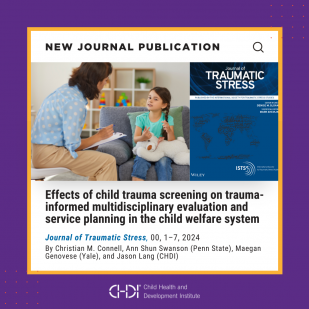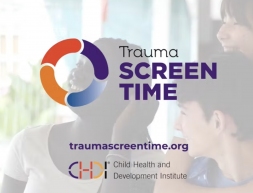
Chief Program Officer Jason Lang, Ph.D. co-authored a new study published in this month's Journal of Traumatic Stress that examined the effects of trauma screening in the Connecticut child welfare system. The study - among the first of its kind - was co-authored with Christian M. Connell, Ph.D. and Ann Shun Swanson of Penn State and Maegan Genovese, M.S. of The Consultation Center at Yale University School of Medicine.
Despite the high prevalence of trauma exposure among children and youth involved in the child welfare system (CWS), there is still significant variation in the implementation and practice of trauma screening across state child welfare systems.
The research team hypothesized that incorporating trauma screening into the mandatory evaluation that occurs when children are removed from their homes would (1) increase the early identification of trauma-related symptoms and (2) increase referrals to and use of trauma-focused, evidence-based treatments.
By conducting a retrospective electronic record review using the Connecticut Department of Children and Families child welfare information system, the researchers found that when routine trauma screening was implemented in multidisciplinary evaluations for children following their removal, their child welfare record had more information about their trauma and a greater likelihood that they were referred for trauma-focused behavioral health services. They also found evidence that screening did, in fact, identify previously unrecognized and unmet needs.
The research team concluded that the "early identification of trauma-related symptoms may help connect children more promptly to trauma-informed evidence-based interventions, which may avert or mitigate the long-term sequelae of child maltreatment and CWS involvement."
However, it is important to note that despite the increased referral rates, the team did not find a corresponding increase in records showing the children actually received trauma-focused services. Possible explanations for this include service unavailability, long waitlists for trauma-focused services that meant children were not able to access services within the case review period, a lack of follow-up with referrals, or caseworkers simply failing to document the receipt of these services. The nationwide shortage in the children's behavioral health workforce is likely contributing to these issues.
The researchers suggest that increasing training for CWS staff, increasing the availability of evidence-based services, and fostering collaboration between CWS and behavioral health providers could help to address this discrepancy and ensure that all children who need trauma-focused services can receive them.
Read the full study findings in the Journal of Traumatic Stress.
 Trauma ScreenTIME
Trauma ScreenTIME
Learn about child trauma screening and how to develop effective screening processes in child-serving organizations in our Trauma ScreenTIME Courses.
Three ScreenTIME Courses are currently available: (1) a Core Course appropriate for any child-serving professional or organization, (2) a Schools Course specific to screening in schools, and (3) a Pediatric Primary Care Course for staff in pediatric settings. All ScreenTIME Courses are eligible for continuing education courses. Learn more and register at www.TraumaScreenTIME.org.
Child Trauma Screen
Download the Child Trauma Screen, a brief trauma screening measure for children ages 6-17.

|
Jason Lang, Ph.D - Chief Program Officer jlang@chdi.org |